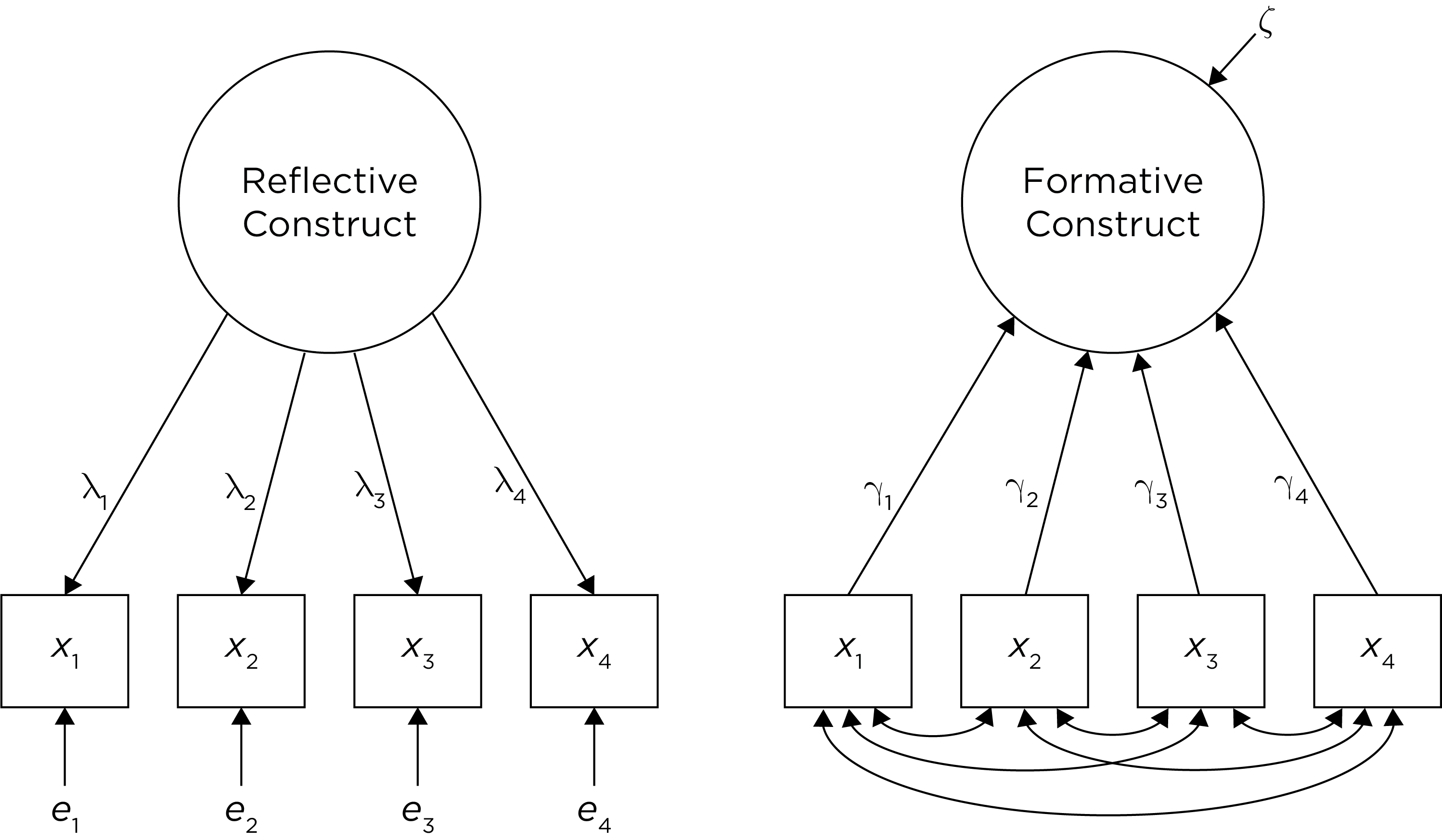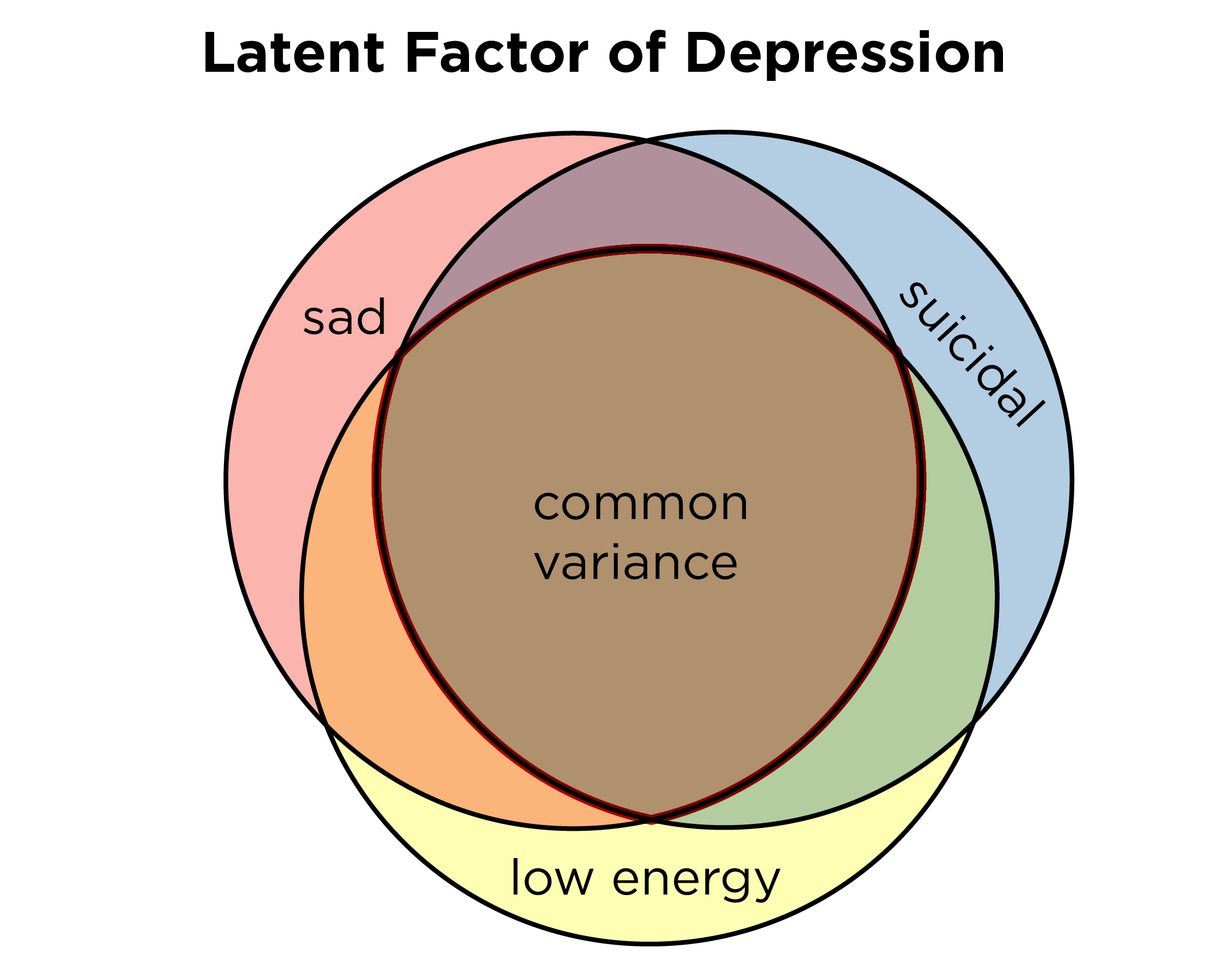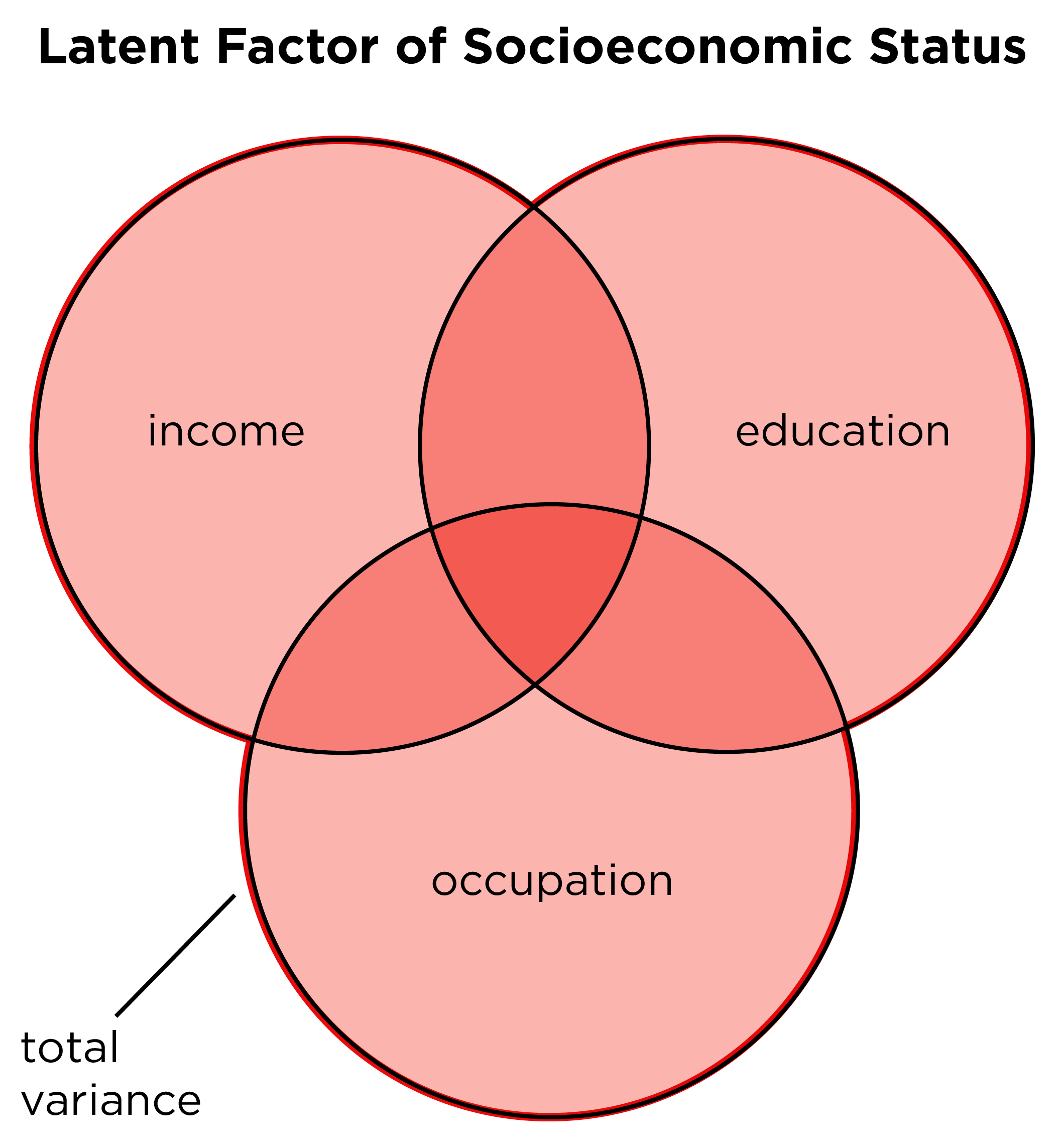I want your feedback to make the book better for you and other readers. If you find typos, errors, or places where the text may be improved, please let me know. The best ways to provide feedback are by GitHub or hypothes.is annotations.
Opening an issue or submitting a pull request on GitHub: https://github.com/isaactpetersen/Principles-Psychological-Assessment
Adding an annotation using hypothes.is.
To add an annotation, select some text and then click the
symbol on the pop-up menu.
To see the annotations of others, click the
symbol in the upper right-hand corner of the page.
3 Constructs
3.1 Types of Constructs
A construct is a concept. A construct is generally considered a latent idea or phenomenon that is not directly observable. For example, depression could be considered a construct because we cannot directly measure someone’s level of depression. Rather, we infer a person’s level on the construct of depression by taking measurements of many indirect proxies that we think are indicators of the construct. An indicator is a measurement, and it could be thought of as a behavior or questionnaire item. Potential indicators of depression could include behaviors/items such as whether the person has low mood, low energy, sleep difficulties, loss of interest in formerly enjoyable activities, changes in weight or appetite, etc.
Because constructs are latent, unobservable phenomena, they are often estimated using latent variable models, as described in Section 3.5.
There are two main types of constructs: reflective constructs and formative constructs.
3.1.1 Reflective Construct
With a reflective construct (or reflective model), the construct is the cause of the measures, and the construct is reflected by the indicators, see Figure 3.1.
An example of a reflective construct is extraversion; see Figure 3.2. We conceptualize extraversion as a latent concept that, although not directly observable, influences the measurements of indicators of extraversion, such as whether the person enjoys talking to strangers, goes to many parties, is energetic, and is happy. In a reflective model, the answers that people give on the items are thought to reflect a certain disposition—in this case, extraversion. None of these indicators, in isolation, is considered a direct measure of extraversion. Nevertheless, we feel that we can get a better estimate of the concept of extraversion by capturing the variance that covaries across these indicators, i.e., the common (systematic) variance among the indicators. Thus, the latent factor is estimated to reflect the common variance among the indicators, as depicted in Figure 3.3. Because a reflective construct influences the indicators, the indicators are called effect indicators. What we observe, theoretically, are the effects of the underlying construct, which influences scores on each individual measure.
With a reflective construct, we would expect that the items would show strong internal consistency reliability. That is, we would expect that the indicators would all be correlated with each other, because all indicators are thought to be a reflection of the underlying construct. But in reality, there is often still residual correlation between items even after accounting for the latent factor.
In a measurement model of a reflective construct (see Figure 3.1), the lambda (\(\lambda\)) values are called factor loadings that represent regression coefficients from observable indicators to latent variables. A factor loading is the relative weight that the item is given in the estimation of the latent factor, similar to the correlation between the construct and the measure. The stronger an item’s factor loading on the construct, the more relative weight a given item has in the estimation of the latent factor. The epsilon (\(\epsilon\)) term reflects measurement error. Structural equation modeling is an application of the same way we think about measurement according to classical test theory, but in a latent variable framework. According to classical test theory, the observed score is thought to be some combination of the true score and error (\(\text{observed score} = \text{true score} + \text{error}\); \(X = T + e\)). Or, in a multiple regression framework: \(\text{extraversion} = \lambda_1 \cdot \text{strangers} + \lambda_2 \cdot \text{parties} + \lambda_3 \cdot \text{happy} + \text{errors}\). That is, the true score influences the observed score on each measure. If a person’s level on the construct (extraversion) changes, their score on each measure/indicator/item is expected to change (Edwards & Bagozzi, 2000).
3.1.2 Formative Construct
Formative constructs are the other fundamental way to understand the relation between a construct and a measure. With a formative construct (or formative model), the measures cause the construct; see Figure 3.1. That is, the construct is created by the measures. Because the indicators influence the formative construct, the indicators are called causal indicators.
Examples of formative constructs include constructs such as socioeconomic status (SES), stress, substance use, risk for cardiovascular disease, and exposure to discrimination. A formative construct is estimated as the total variance among the indicators, as depicted in Figure 3.5. For instance, we may define SES such that it is the linear combination of a person’s educational attainment, occupational prestige, and income, as in Figure 3.4. With a formative construct, if a person changes in their level on the construct, we might not expect that their scores on all of the measures/indicators/items would change (Edwards & Bagozzi, 2000). If a person’s SES changes, you would not necessarily expect the person’s score on all of these measures/items to change. For instance, if a person’s SES increases from T1 to T2, you would not necessarily expect that their educational attainment increased; it could be instead that their occupational prestige or income increased.
In a structural equation model, the gamma (\(\gamma\)) values are regression coefficients from exogenous variables to endogenous variables. Endogenous variables are variables whose values are determined by the model (i.e., they are influenced by other variables), whereas exogenous variables are variables whose values are not determined by the model (i.e., they are not influenced by other variables). In a measurement model of a formative construct (see Figure 3.1), the gamma values reflect the relative weight that the item is given in the estimation of the latent factor, similar to the correlation between the construct and the measure. The stronger an item’s factor loading on the construct, the more relative weight a given item has in the estimation of the latent factor.
With a formative construct, the disturbance term, zeta (\(\zeta\)), represents the part of the construct that is not explained by the measures, i.e., the measurement error. However, the measures are thought (or at least assumed) to be error-free causes of the construct. The covariances between the indicators are permissive of item correlations, but unlike the reflective model, the formative model does not require that the items are correlated. In other words, for a formative model, it is not necessary that the items are correlated, even though the items could be correlated.
A formative construct is determined by the measures, so if you change the measures, you change the construct. A formative model requires that you include all facets (aspects) of the construct. This is not true in a reflective model because all items of a unidimensional reflective construct are interchangeable as long as the construct is unidimensional and the items are equally reliable because the construct influences the measure scores. With a reflective construct, all you need to do is find the items that reflect the underlying construct, and you could create parallel measures of the construct. This is impossible to do in a formative model.
Although formative conceptualizations of constructs may be useful in some cases, formative constructs can be controversial (Edwards, 2011; Hardin et al., 2011; Howell et al., 2007; Markus, 2018; Bollen & Bauldry, 2011; Bollen & Diamantopoulos, 2017; but see Bollen & Lennox, 1991; Diamantopoulos et al., 2008). It is important to think carefully about the construct of interest, as guided by theory, and how best to assess and estimate it.
3.2 Differences in Measurement Expectations
There are several differences in our measurement expectations based on the type of construct (formative or reflective) or indicator (causal or effect), as described by Bollen and Lennox (1991).
One difference we would expect between effect versus causal indicators is the actual correlations between the indicators. Causal indicators may not be correlated, whereas effect indicators must be correlated. So, when we are assessing internal consistency reliability of a measure, and we assume that higher correlations between items suggests higher internal consistency reliability, we are assuming that indicators of the construct have an effects relation to the construct. A scale assessing causal indicators would likely have very low internal consistency reliability.
A second difference we would expect between effect versus causal indicators is whether to use a sample or a census of indicators. The suggestions that we sample all facets of a construct when determining indicators is necessary only for causal indicators, for which a failure to assess a certain formative indicator changes the overall meaning of the construct. For effect indicators of a unidimensional construct, equally reliable measures are interchangeable.
A third difference we would expect between effect versus causal indicators is the optimal correlations between the indicators. For effect indicators, high correlations are desirable. For causal indicators, too high of a correlation between indicators is likely to introduce the problem of multicollinearity, so lower correlations are optimal. Multicollinearity is when two or more predictors are correlated such that their regression coefficients with the outcome variable (in this case, the factor loadings on the latent factor, i.e., \(\lambda\)) are erratic.
3.3 Practical Issues
There are important practical issues to consider with both reflective and formative models.
As described in Section 7.4 in the chapter on structural equation modeling, it is challenging to use formative constructs in a latent variable framework. In a structural equation modeling (SEM) framework, formative constructs must be used in the context of a model that allows some constraints. But one can easily estimate formative constructs outside of a SEM context, for example, with an average or weighted average composite, similar to principal component analysis. However, unlike latent variable approaches, linear composite approaches (e.g., mean or sum scores) do not account for measurement error. That is, linear composite approaches do not include a disturbance/error term. Therefore, a linear composite is not the same as a latent variable. If no disturbance term is included in a structural equation model, the model is equivalent to a linear composite approach (e.g., sum score, weighted average). Linear composite approaches are likely more defensible for formative constructs than for reflective constructs.
3.4 How To Estimate
To estimate a reflective construct, a latent variable modeling approach is necessary, such as structural equation modeling, factor analysis, or item response theory.
To estimate a formative construct, one may estimate an average or sum score across items (which gives each item equal weight), estimate a weighted average, use principal component analysis, use confirmatory composite analysis, use partial least squares regression, or use structural equation modeling.
Thus, it is important to think about the nature of the construct before deciding how to estimate it. The nature of a construct is a theoretical question. Data alone cannot determine whether a construct is reflective or formative. Just because items are highly correlated does not mean that scientists think of the construct as reflective. By contrast, if items are not highly correlated, it suggests that a single unidimensional reflective construct may not adequately capture reality—the variance may be better captured by a formative or by multiple reflective constructs (i.e., a multidimensional model). In sum, although empiricism is relevant, theory is necessary to inform our understanding of the nature of constructs.
3.5 Latent Variable Modeling: IRT, SEM, and Factor Analysis
Item response theory (IRT), structural equation modeling (SEM), confirmatory composite analysis (CCA), and factor analysis are all approaches to latent variable modeling. Factor analysis and IRT most commonly estimate reflective latent variables rather than formative latent variables. CCA estimates formative latent variables. SEM can estimate both reflective and formative latent variables. IRT is essentially a form of confirmatory factor analysis with categorical, binary, or ordinal data. As we discuss in Chapter 7, SEM is confirmatory factor analysis with regression paths that specify hypothesized causal relations between the latent variables (the structural component of the model). As we discuss in Section 14.1.4.3.3, exploratory structural equation modeling (ESEM) is a form of SEM that allows for a combination of exploratory factor analysis and confirmatory factor analysis to estimate reflective latent variables and the relations between them.
3.6 Alternative Conceptualizations of Phenomena: A Network
Reflective and formative constructs are considered latent variables. However, there are alternative conceptualizations of phenomena and psychopathology. For instance, one alternative approach is to conceptualize psychopathology as a characteristic that emerges out of the local influences of symptoms on other symptoms. This would be consistent with a network analysis approach to conceptualization of psychopathology. In the network analysis conceptualization, “depression” as a latent construct does not exist; what we call “depression” merely represents the influences of various symptoms on one another. In this approach, if only one item is used to assess each symptom, then the symptoms are observed (manifest) variables that are assumed to be measured without error.
Note that the existence of latent constructs and local influences is not mutually exclusive. It could be for a given phenomenon, for instance, that there are underlying processes (representing a latent factor) that lead to a wide range of symptoms; and, simultaneously, that behaviors/symptoms/processes influence one another in a network.
3.7 Conclusion
It is important to think about the nature of a construct before deciding how to estimate it. For a formative construct, the indicators influence the construct, and a linear composite such as a weighted mean or sum score is justifiable. For a reflective construct, the construct influences the indicators, and it is more appropriate to estimate it with a reflective latent variable that reflects the common variance among the indicators using structural equation modeling, factor analysis, or item response theory.
3.8 Suggested Readings
Bollen & Lennox (1991); Bollen & Bauldry (2011); Bollen & Diamantopoulos (2017)




